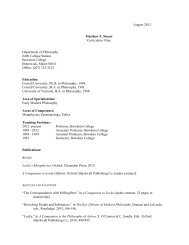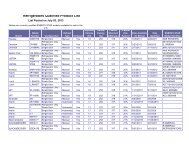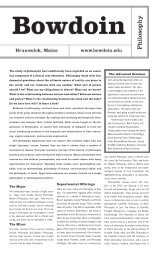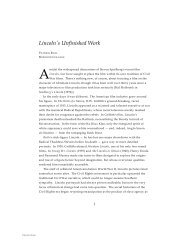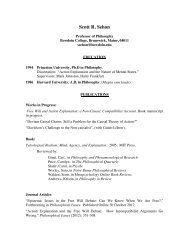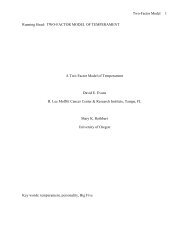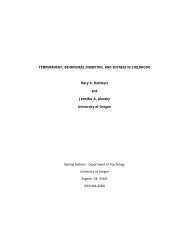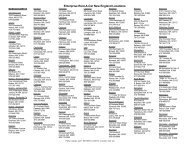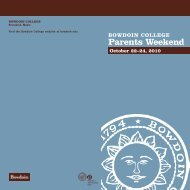Slides
Slides
Slides
Create successful ePaper yourself
Turn your PDF publications into a flip-book with our unique Google optimized e-Paper software.
History of infectious disease &<br />
introduction to epidemiology<br />
• Goals and requirements for Bio067<br />
• Germ-theory of disease: A 350 year epic<br />
• Scientific methods<br />
• Epidemiology and public health<br />
• Environmental vs. mechanistic explanations<br />
of disease<br />
Bio 067 course website<br />
Explore, use and contribute!<br />
http://www.bowdoin.edu/faculty/a/amcbride/<br />
courses/bio067<br />
Goals for Biology 067<br />
• Understand the biology behind infectious diseases<br />
– What are infectious agents?<br />
– How do they interact with hosts?<br />
• Learn how scientific research leads to the<br />
identification and understanding of infectious agents<br />
• Explore factors that contribute to the spread of<br />
disease<br />
• Become skilled at asking questions and determining<br />
how they can be addressed<br />
Goals for Biology 067<br />
• Learn to analyze sources of information about<br />
infectious diseases<br />
• Practice working collaboratively with colleagues<br />
• Improve communication skills<br />
Requirements for Biology 067<br />
• Midterm & Final<br />
• Group project<br />
• Laboratory work<br />
• CLASS PARTICIPATION<br />
• Class activities, discussions of readings, asking questions<br />
Germ theory of disease: Timeline<br />
1530 1683 1796 1848 1854 1860s 1876<br />
Fracastoro<br />
Contagion spread<br />
by direct or<br />
indirect contact<br />
Van Leeuwenhoek<br />
“Animacules” in<br />
tooth plaque<br />
Pasteur<br />
Germ theory<br />
of disease<br />
Pictures from Encyclopedia Britannica<br />
http://search.eb.com<br />
1
Scientific Methods<br />
Scientific Methods<br />
Empiricism: Way to gain knowledge primarily<br />
guided by experience and observation<br />
Empiricism<br />
Theory or observation<br />
Review existing information<br />
Define/refine the hypothesis<br />
Hypothetico<br />
Deductive<br />
Reasoning<br />
“Hypothetico-deductive” reasoning:<br />
Hypothesis generation, testing, and refinement<br />
of hypothesis<br />
Design study<br />
Collect and analyze data<br />
Formulate conclusions<br />
Adapted from Gerstman “Epidemiology Kept Simple” (1998), Chapter 1<br />
Adapted from Gerstman “Epidemiology Kept Simple” (1998), Chapter 1<br />
Germ theory of disease: Timeline<br />
1530 1683 1796 1848 1854 1860s 1876<br />
Fracastoro<br />
Contagion spread<br />
by direct or<br />
indirect contact<br />
Van Leeuwenhoek<br />
“Animacules” in<br />
tooth plaque<br />
Jenner<br />
Vaccination to<br />
prevent smallpox<br />
Edward Jenner<br />
1798<br />
"An inquiry into the causes and<br />
effects of the variolae vaccinae, a<br />
disease discovered in some of the<br />
western counties of England,<br />
particularly Gloucestershire, and<br />
known by the name of The Cow Pox"<br />
Pictures from Encyclopedia Britannica<br />
http://search.eb.com<br />
Semmelweiss museum Budapest, Hungary<br />
in Milestones in Microbiology, ed. T. Brock<br />
(1961), (Washington, DC: ASM Press) pp. 121-125.<br />
Jenner's observations<br />
• During smallpox outbreaks, dairy-maids had<br />
lower incidence of smallpox than others.<br />
• When servants milked cows with cowpoxinfected<br />
udders, "inflamed spots" appeared on<br />
their hands.<br />
• When these subjects received smallpox<br />
inoculations, they did not show symptoms.<br />
(Jenner, E., 1798, p. 121)<br />
Hypothesis<br />
People with minor cases of cowpox become resistant to smallpox.<br />
Test<br />
May 14, 1796: Inserted "matter" from an infected dairy-maid's<br />
hand into "superficial incisions" in the arm of William Summers.<br />
May 23, 1796: Summers "was perceptibly indisposed."<br />
July 1, 1796: Inserted "variolous matter" from a smallpox patient<br />
into "slight punctures and incisions" Summers' arms.<br />
Result<br />
"No effect was produced on the constitution" of<br />
Summers following smallpox inoculation.<br />
(Jenner, E., 1798, p. 123)<br />
2
Germ theory of disease: Timeline<br />
Fracastoro<br />
Contagion spread<br />
by direct or<br />
indirect contact<br />
Van Leeuwenhoek<br />
“Animacules” in<br />
tooth plaque<br />
1530 1683 1796 1848 1854 1860s 1876<br />
Jenner<br />
Vaccination with<br />
cowpox protects<br />
from smallpox<br />
Semmelweis<br />
Antiseptic<br />
method<br />
Ignaz Semmelweis<br />
1818-1865<br />
•Assistant, obstetric clinic<br />
Vienna, 1844<br />
•Hospital childbirth mortality<br />
rate 25-30% (puerperal fever)<br />
•Hypothesis: Students carrying<br />
infection to mothers<br />
•Test: Wound transmission<br />
Pictures from Encyclopedia Britannica<br />
http://search.eb.com<br />
http://clendening.kumc.edu/dc/pc/semmelweis01.jpg<br />
Solution for Puerperal Fever<br />
Diseases in populations<br />
Endemic Epidemic Pandemic<br />
within upon all<br />
Handwashing<br />
Demios = the people<br />
Semmelweiss museum Budapest, Hungary<br />
Epidemiology and Public Health<br />
Germ theory of disease: Timeline<br />
Epidemiology: The study of the causes,<br />
transmission, incidence, and prevalence of<br />
disease and health-related events in populations<br />
Public Health: Organized community effort to<br />
prevent disease and promote health<br />
Fracastoro<br />
Contagion spread<br />
by direct or<br />
indirect contact<br />
Van Leeuwenhoek<br />
“Animacules” in<br />
tooth plaque<br />
1530 1683 1796 1848 1854 1860s 1876<br />
Jenner<br />
Vaccination with<br />
cowpox protects<br />
from smallpox<br />
Semmelweis<br />
Antiseptic<br />
method<br />
Snow<br />
Cholera in<br />
drinking<br />
water<br />
From Gerstman “Epidemiology Kept Simple” (1998), p. 3.<br />
Pictures from Encyclopedia Britannica<br />
http://search.eb.com<br />
3
John Snow’s map of the 1854 cholera epidemic<br />
See Fig. 1.2 and Table 1.4 in Gerstman Ch. 1<br />
Environmental vs. mechanistic<br />
views of disease<br />
Environmental/non-mechanistic view:<br />
Diseases are caused by environmental<br />
conditions and can therefore be controlled<br />
by improving the environment<br />
Mechanistic view: Diseases are caused by<br />
specific microbes and can therefore be<br />
controlled by fighting the microbe<br />
http://www.nationalgeographic.com/resources/ngo/education/ideas912/912choleraho3.html<br />
Germ theory of disease: Timeline<br />
Fracastoro<br />
Contagion spread<br />
by direct or<br />
indirect contact<br />
Van Leeuwenhoek<br />
“Animacules” in<br />
tooth plaque<br />
1530 1683 1796 1848 1854 1860s 1876<br />
Jenner<br />
Vaccination with<br />
cowpox protects<br />
from smallpox<br />
Semmelweis<br />
Antiseptic<br />
method<br />
Snow<br />
Cholera in<br />
drinking<br />
water<br />
Pasteur<br />
Germ theory<br />
of disease<br />
Koch<br />
Experimental<br />
procedure to<br />
determine<br />
infectious agent<br />
>20 key<br />
discoveries<br />
2000<br />
Information I will request by email<br />
Name Year Major (potential)<br />
Home town<br />
Science background (Bowdoin & before)<br />
Why are you taking Bio 067?<br />
What do you want to learn this semester?<br />
What question(s) do you have about emerging<br />
infectious diseases?<br />
Pictures from Encyclopedia Britannica<br />
http://search.eb.com<br />
4




